Sometimes it helps to not know what you’re doing.
It forces you to mine your ingenuity — to fall back on what you do know, and use that filed-away information to solve the task at hand. For a lot of us fly fishers, that’s how we learned the craft. A bit at a time, learning lessons along the way. Trial and lots of error. And it never really stops. As long as we keep fishing, we keep getting better.
With that in mind, I stood atop the steep concrete lip of Brays Bayou in the heart of urban Houston, gazing through polarized lenses at the green-tinged water as it coursed its way toward its wedding with the much larger Buffalo Bayou that eventually dumps into Trinity Bay. I watched as a sizable Amur grass carp moved out of the current and up onto the shallow “pan” of the cement raceway. The fish, about two feet long, nosed the surface and a tiny, fluffy seed pod drifting along with the purposeful current disappeared.
“You see that?” asked Rob McConnell, an avid Houston angler and the author of Fly Fishing Houston & Southeast Texas. Rob was showing me around the city and helping me sample a number of Houston’s gritty, inner-city fisheries, most of which can be accessed on foot. In fact, in three days spent fishing, we averaged about five miles a day of walking, spotting fish and casting. The best part? No other anglers.
“That was an eat.”
It was subtle. If I hadn’t been paying attention, I wouldn’t have even noticed it. And that’s kind of the theme for Brays, White Oak and Simms bayous—among the other smaller and larger creeks and streams — that pulse through the city, contained by concrete and progress yet surprisingly resilient when it comes to their piscine assets. Most folks, even the people who live in Houston and cross these bayous via road and highway bridges every single day, just don’t bother to pay attention. They barely notice them.
For the average fly fisher, this makes for virtually limitless and uncrowded angling for everything from Amur grass carp, common carp, buffalo, gar, bass, panfish, Mayan cichlids and even redfish and speckled trout that move up these city ditches from Trinity Bay. Even better? It’s largely a visual game — it’s a unique form of urban spot-and-stalk angling that requires a bit of stealth, a solid fly cast … and you really need to pay attention.
But, I learned, you don’t necessarily have to know what you’re doing to be successful.
Fly fishing algebra
Tuning out the sounds of traffic and the ever-present “buzz” that tends to vibrate between the concrete walls of the bayou, I opened my fly box and looked for something — anything — that would resemble that little seed pod. If that’s what the fish are eating, that’s what I needed to feed them. It’s just conventional wisdom among fly fishers.
Rob fishes for the grass carp at a pretty regular clip — but he generally doesn’t do it with dry flies. Instead, he crafts little clusters of dubbing and spiky rubber legs, and drifts them by the rangy vegetarians in hopes that they represent some of the scummy plant detritus that no doubt moves along the current of this semi-clear creek. And, yes, sometimes the carp actually eat the flies.
But the dry-fly fishing for these carp, Rob later told me, isn’t really a thing. Occasionally, he said, you’ll hear a story about somebody hooking one on a dry fly, but, for the most part, the anglers who enjoy the most success casting to these uber-picky fish do it using subsurface patterns, like the flies he uses.
But what the hell did I know? I just saw a big grass carp rise and eat a fluffy bit of cottony, seedy goodness.
I dug deep into my backpack and pulled out a small fly box left over from a recent trip to the Yukon. There, stuck in the foam, was a size 16 Parachute Adams — a generic mayfly imitation that serves as a solid attractor fly for trout and grayling. It’s fluffy, like that seed pod.
Rob kind of sniggered as I tied it on. He knew something I didn’t know, and it didn’t take me long to find out what he was giggling at. As I coated the feather-and-Antron concoction with greasy fly floatant so it would ride high and dry in the current, I looked again to make sure the big fish was still there. It took me a few seconds, but I spied it just on the lip of the concrete pan. And then I realized that I likely need to get closer. Like … a lot closer.
The bayou is only about 30 or 40 feet across from the near edge of the water to the far edge. But, from the lip of the ditch, it was 30 or 40 feet to the water (and a good 15 or 20 feet into the bowels of the ditch). It was going to take a long cast across the bayou to where the fish kind of passively moved back and forth, onto the pan to grab something to eat and then off the pan to hold in deeper water. I’d have to get down there a bit, and then I’d have to deal with the bayou’s subtle, yet swift, current.
This is as close to algebra as fly fishing gets … current, drift and presentation. These are the variables. Defy one, and another can cost you a fish.

Add in another factor. This bright, sunny October day left open the possibility that the notoriously cautious grass carp might get a glimpse of my silhouette and just sort ghost away into the deeper channel and sulk the afternoon away.
So, taking care to move slowly, I started to descend into the ditch, the rubber soles of my wading boots ably gripping the sloped, grooved concrete of the channel.
“This is steeper than it looks,” I said quietly to Rob. It was so steep that my toes pushed against the insides of my boots, and I feared, if I had to do this all day, I’d lose a toenail or two. So I turned sideways and kind of crab-walked farther into the contained bayou. Finally, I felt as though I could make a serviceable cast.
I relocated the carp which had just moved back onto the pan of the creek, likely looking for a bite to eat. Peeling fly line off of my reel and stacking it at my cock-eyed feet, I kept an eye on the big fish and started my cast. That’s when I realized I’d omitted a couple of important considerations.
First, even though I felt pretty good about the distance the cast would require (maybe 50 feet), my fly line would very likely catch the faster current in the middle of the bayou and cause my little Adams to “drag” through the target zone. And, since the puffy little seed pods float along the edges of the creek at the exact speed of the current, that movement on the fly would look anything but natural.
Second, the concrete channel was so steep that I had to take it into account when I made my backcast. I didn’t want to catch my line or my fly on the concrete behind me.
“Now you know why I was laughing,” Rob said. Indeed. It was proving to be much more difficult than I initially anticipated. But I was already in the guts of the bayou — I had to give it a shot.
I started my cast and, borrowing from my saltwater fly fishing experience, threw in a double haul to help me boost the distance a bit. Then I had to lift my backcast vertically using what’s called a “steeple cast,” so I could clear the hardpan lip of the channel behind me. Finally, to make sure the fly would drift naturally through the target zone, I had to perform a makeshift “reach cast” so the fly line would land upstream of the fly. I’d eventually have to deal with the drag, but if I could make the Adams float over the carp for just a few seconds, I figured my chances at hooking up were pretty good.
As I started to cast, I was worried that the fish would spook at the movement, but I suspect I was far enough into the channel that the fish didn’t notice me amid the concrete backdrop. It stayed in its feeding lane, just as I hoped.
After performing the fly fishing equivalent of a contortionist’s act, I dropped the fly about five feet above the fish, and for a good second or two, the fly floated just like one of those puffy seed pods. Just as the fly line got caught in the current and started to drag the fly, the big, exotic carp from eastern Asia rose to the surface and sucked in the Adams.
I’m not sure who was more surprised — me, the fish or Rob, who let loose with a holler from atop the ditch. The fish pulled tight, and I felt a bit like the dog that caught the bumper of the car it had been chasing. The first words out of my mouth aptly told the tale.
“Now what?” I asked. I think Rob was still in a stage of disbelief. The fish was pulling hard and taking line from my reel as it pulsed into the current of the bayou. I tried to give chase, but the sloped channel made for tough walking, let alone the little gallup I had to perform to keep the fish on the line. Predictably, after about half a minute, the fish spit the fly and the whole ordeal came to a merciful end.
“I can’t believe what I just saw,” Rob said. “You’re down here throwing saltwater casts at a ditch carp. That’s not supposed to work!”
“I’m glad you didn’t tell me that,” I said. Had I known what I was doing, I may not have even connected with that incredible creature in the first place.
That’s technical fly angling for “trash” fish in the gray, concrete heart of H-town.

Once a neighborhood, now a fishery
The city of Houston has a program in place that, thanks to repeated flooding after large storms, allows it to acquire homes that have persistently flooded and simply raze them. The result is open space that can be used for recreation. Sometimes the sales are voluntary. Sometimes, when the damage is habitual and the cleanup is costly, the acquisitions are performed for the good of the city.
In the Inwood Forest neighborhood in northwest Houston, tiny Vogel Creek runs through what used to be fairly nice housing development. But after Hurricane Harvcey blew through in 2017 and flooded everything out, the city negotiated the acquisition of all the homes within the creek’s modest floodplain. The storm marked the seventh flood in seven years for Inwood Forest. It was the last straw for the city’s flood control district.
In October 2022, Mayor Sylvester Turner announced that the city received approval from Federal Emergency Management Agency Administrator Deanne Criswell to put its reclamation plan in place. The city will put more than $52 million to work constructing flood basins in the former housing development. These basins will hold enough stormwater to fill the Astrodome while also protecting some 4,500 homes and structures in the area from future floods.
With the houses now gone along Vogel Creek, which is a tributary to White Oak Bayou, the little waterway has transformed into an honest-to-God urban fishery. And while it is contained within concrete raceways as it flows under a few busy city traffic arteries, for the most part, Vogel is a pastoral little oasis hidden among strip malls, a community college and some apartment complexes.
That’s not to say it doesn’t have its challenges. Homeless Houstonians have erected some small tent cities, and, predictably, crime in the area is on the rise. When I visited, McConnell offered some simple advice.
“Just don’t get out of sight of your rental car.”
Daunting. Then I remembered the can of bear spray Rob carried on his hip as we wandered the concrete bayou the day before. It’s a different kind of wilderness, and, I understood, it wasn’t without risk.
But, he promised, the fishing would be worth it.
And Rob’s a man of his word. As I strung up a little 3-weight fly rod and walked across the manicured centipede grass planted where flooded-out homes used to stand, I got my first glimpse of the stream. It October, it ran cool and clear, and I spooked a foot-long largemouth that was nestled up under an overhanging snag — it darted downstream into deeper water. It was a quick lesson, though. Just like a Rocky Mountain spring creek, stealth would matter on this little urban gem.

I slowly worked my way upstream, taking care not to leave a long shadow or make too much noise. Minutes after spooking that first fish, I saw a rise ring about 20 feet ahead of me. I froze.
There, acting incredibly like a chalk stream brown trout, a chunky largemouth hung in the current, tight to the bank. And, just like a trout, it was ever the opportunist.
I stepped back a few feet and clipped off the small Woolly Bugger I tied to my tippet at the car. Looking through my fly box and then taking a look around to see what bugs might be crawling around the cityscape, I went back to my old standby: the Adams.
Yup. The trout-fly-turned-grass-carp-fly would now get its chance to entice a big-city, creek-dwelling largie. You can take the boy off the trout stream, but …
I greased the dry fly up, and stepped closer to the creek. The bass was still there. I watched for a bit, and every now and then, the beefy fish would slide into the current away from the bank as if considering something to eat. Then, as if I’d planned it all along, a hapless little moth hovered over the creek just a bit too long about two feet above the bass.
With lightning speed, the bass surged into the current and actually left the water in pursuit of the insect. Just as the fish broke the surface, the moth levitated and flitted along into the city’s ether. The bass, having missed the meal, ghosted into the depths.
Fearing I missed my chance, I stood still and quiet for a minute or two, and then, as I hoped, the largemouth kind of drifted out of the deeper water and reclaimed its ambush position under a copse of overhanging grass.

I let out some line and made a quick cast. The Adams landed just above the bass, but I honestly believe I could have put the bug anywhere. There was no hesitation. The largemouth burst from the water and grabbed the fly. Minutes later, I was holding my first Texas largemouth since I was a kid living in East Texas who snuck onto farm ponds and crawled through the brush for the chance to fish.
It was a very familiar moment. A trout fly. A small stream. A rising fish. I could have been in Idaho.
But then I thought better of it. On my favorite little cutthroat trout stream about 40 minutes from home, I haven’t enjoyed a quiet day of solitude for a few years now. As I looked around the once-flourishing neighborhood, I realized I was completely alone.
Alone in one of the fastest-growing cities in America. With a fly rod and wild, willing fish.
An urban lesson
I suppose a trip like this could have unfolded in any number of American cities where, out of perceived necessity, once-wild rivers and streams are domesticated and funneled into concrete ditches with the sole purpose of moving water from Point A to Point B.
But even then, nature has a way of winning out … of persisting even as we try like hell to keep it at bay. On that first day, as Rob and I walked through the concrete containers keeping the city’s bayous from doing anything unpredictable, the thing I noticed most was how resilient and adaptable the natural world can be.
When faced with the challenges presented by our ever-present desire to channel, maneuver, direct and control the world around us, magic still happens. As Dr. Ian Malcom said in Michael Chriton’s Jurassic Park, “Life finds a way.”
In the bowels of Houston’s carefully constructed and maintained drainage system, great blue herons wade and hunt among the shallows of the concrete-lined creeks. Ospreys grab grass carp and cichlids from slow water.
And fly fishers, without a care — and definitely without a clue — cast to wild fish, oblivious to the vibrant city that pulses around them and shoulders nature into odd contortions.
But nature deals with it. So, too, do Houston’s devoted fly rodders.





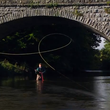





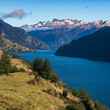



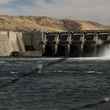




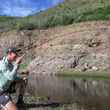
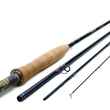



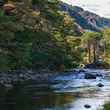
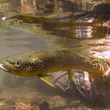


Comments
JP Roylance replied on Permalink
Great story
Pages